Contingent election
In the United States, a contingent election is the procedure used to elect the president or vice president in the event that no candidate for one or both of these offices wins an absolute majority of votes in the Electoral College. A presidential contingent election is decided by a special vote of the United States House of Representatives, while a vice-presidential contingent election is decided by a vote of the United States Senate. During a contingent election in the House, each state's delegation casts one en bloc vote to determine the president, rather than a vote from each representative. Senators, on the other hand, cast votes individually for vice president.
The contingent election process was originally established in Article Two, Section 1, Clause 3 of the United States Constitution. The procedure was modified by the 12th Amendment in 1804, under which the House chooses one of the three candidates who received the most electoral votes, while the Senate chooses one of the two candidates who received the most electoral votes. The phrase "contingent election" is not found in the text of the Constitution but has been used to describe this procedure since at least 1823.[1]
Contingent elections have occurred only three times in American history: in 1801, 1825, and 1837. In 1800, Thomas Jefferson and Aaron Burr, the presidential and vice-presidential nominees on the ticket of the Democratic-Republican Party, received the same number of electoral votes. Under the procedures in place at the time, this necessitated a contingent election the following year to decide which would be president and which vice president. In 1824, the Electoral College was split between four candidates, with Andrew Jackson losing the subsequent contingent election to John Quincy Adams, despite having won a plurality of both the popular and electoral vote. In 1836, faithless electors in Virginia refused to vote for Martin Van Buren's vice-presidential nominee Richard Mentor Johnson, denying him a majority of the electoral vote and forcing the Senate to elect him in a contingent election.
The three past contingent elections were held by the outgoing Congress, since, at the time, congressional terms ended / began on March 4, the same day as presidential terms. In 1933, the 20th Amendment moved the congressional term end / start date to an earlier date (January 3) in the year than the new January 20 presidential term end / start date. The amendment reduced the length of lame-duck sessions of Congress. As a result, the contingent elections are conducted by the incoming Congress.[2]
Electoral College overview
In the United States, the president and vice president are indirectly elected by the Electoral College, which, since ratification of the 23rd Amendment in 1961, consists of presidential electors from the 50 states and the District of Columbia. The current total of 538 electors that make up the Electoral College are directly elected by their respective states. Since the election of 1824, a majority of the states have chosen their electors on a statewide winner-take-all basis, based on the statewide popular vote on Election Day.[3] Maine and Nebraska are the only two current exceptions, as both states use the congressional district method. Although ballots list the names of the presidential and vice presidential candidates (who run on a ticket), voters actually choose electors when they vote for president and vice president. These presidential electors in turn cast electoral votes for those two offices. Electors usually pledge to vote for their party's nominee, but some "faithless electors" have voted for other candidates.
A candidate must receive an absolute majority of electoral votes (currently 270) to win the presidency or the vice presidency. If no candidate receives a majority in the election for president or vice president, that election is determined via a contingency procedure established by the 12th Amendment. In such a situation, the House chooses one of the top three presidential electoral vote-winners as the president, while the Senate chooses one of the top two vice presidential electoral vote-winners as vice president.
Section 3 of the 20th Amendment specifies that if the House of Representatives has not chosen a president-elect in time for the inauguration (noon on January 20), then the vice president-elect becomes acting president until the House selects a president. Section 3 also specifies that Congress may statutorily provide for who will be acting president if there is neither a president-elect nor a vice president-elect in time for the inauguration. Under the Presidential Succession Act of 1947, the Speaker of the House would become acting president until either the House selects a president or the Senate selects a vice president. None of these situations has ever occurred. The Constitution's silence on this point could have caused a constitutional crisis in the 1801 contingent election, as the House of Representatives seemed for a time to be unable to resolve the Jefferson–Burr Electoral College deadlock.[4]
Procedures
Presidential election
If no candidate for president receives an absolute majority of the electoral votes, pursuant to the 12th Amendment, the House of Representatives is required to go into session immediately to choose a president from among the three candidates who received the most electoral votes. Each state's delegation votes en bloc, with each having a single vote. A candidate must receive an absolute majority of state delegation votes (currently 26 votes) to become the president-elect. The House continues balloting until it elects a president. As a consequence of the state delegation voting method, the party that holds the majority in the House could still lose the contingent election if the minority party holds the majority of state delegations.[5] The District of Columbia, which is not a state, does not receive a vote; the 23rd Amendment, which grants the district electoral votes, does not grant the District of Columbia a vote in contingent elections.
Historically, a delegation that did not give a majority of its vote to any one candidate was marked as "divided" and thus did not award its vote to any candidate. This practice, set by House rule, was responsible for turning the Jefferson–Burr election of 1801 into a multiple ballot election. This rule was also followed in 1825 but was not a factor in the outcome. The contingent presidential elections to date have been held in closed session, with the vote of each individual representative not being revealed outside the House Journal. The Constitution does not require a contingent election to be in closed session, and a future contingent election could be held in an open session with public voting.[2]
Vice-presidential election
If no candidate for vice president receives a majority of the electoral votes, pursuant to the 12th Amendment, the Senate is required to go into session immediately to choose the vice president from the two candidates who received the most electoral votes. Unlike in the House, senators cast votes individually in this election. Because the Senate votes independently from the House during a contingent election, the House's presidential selection and the Senate's vice presidential selection could be from opposing parties.[6]
Additionally, the 12th Amendment requires an "majority of the whole number" of Senators (currently 51 of 100) to elect the vice president in contingent election. In practical terms, this means that an absence or an abstention from voting is equivalent to a negative vote and may impair the ability of both candidates to win election.[7] The explicit constitutional language about election by a majority of the whole number of senators may preclude the sitting vice president from breaking any tie which might occur,[8] although some academics and journalists have speculated to the contrary.[6]
Past contingent elections
Presidential election of 1800
The 1800 presidential election was to be decided under processes set out in the original Constitution. It pitted Democratic-Republican ticket Thomas Jefferson and Aaron Burr against Federalist Party ticket John Adams and Charles Cotesworth Pinckney. Under the Constitution scheme, each elector cast two votes, with no distinction between votes for president and for vice president, and the person receiving a majority of votes was elected president and the person receiving the second highest number of votes was elected vice president. Each party formed a plan in which one of their respective electors would vote for a third candidate or abstain, so that their preferred presidential candidate (Adams for the Federalists and Jefferson for the Democratic-Republicans) would win one more vote than the party's other nominee. Democratic-Republicans failed to execute the plan, however, resulting in a tie between Jefferson and Burr with 73 electoral votes each, and a third place finish for Adams with 65 votes.[9]
The Constitution also mandates that, "if there be more than one who have such Majority, and have an equal Number of Votes, then the House of Representatives shall immediately chuse [sic] by Ballot one of them for President." Therefore, Jefferson and Burr were admitted as candidates in the House election. Although the congressional election of 1800 turned over majority control of the House of Representatives to the Democratic-Republicans, the presidential election would be decided by the outgoing House, which had a Federalist majority.[9][10]
Even so, under the Constitution, in contingent elections the votes for the president are taken by states, the representation from each state having one vote; consequently, in 1801, neither party had a majority as some states had split delegations. Given this deadlock, Democratic-Republican representatives, who generally favored Jefferson for president, contemplated two distasteful possible outcomes: either the Federalists manage to engineer a victory for Burr, or they refused to break the deadlock; the second scenario would leave a Federalist, Secretary of State John Marshall, as acting president come Inauguration Day.[11]
Over the course of seven days, from February 11 to 17, the House cast a total of 35 ballots, with Jefferson receiving the votes of eight state delegations each time, one short of the necessary majority of nine. On February 17, on the 36th ballot, Jefferson was elected after several Federalist representatives cast blank ballots, resulting in Maryland and Vermont's votes changing from no selection to Jefferson, thus giving him the votes of 10 states and the presidency.[9][10] This situation was the impetus for the passage of the 12th Amendment, which provides for separate elections for president and vice president in the Electoral College.[9]
Presidential election of 1824
The 1824 presidential election came at the end of the Era of Good Feelings in American politics and featured four candidates who won electoral votes: Andrew Jackson, John Quincy Adams, William H. Crawford, and Henry Clay. While Andrew Jackson received more electoral and popular votes than any other candidate, he did not receive the majority of 131 electoral votes required to win the election, leading to a contingent election in the House of Representatives. Vice presidential candidate John C. Calhoun easily defeated his rivals, as the support of both the Adams and Jackson camps gave him an unassailable lead over the other candidates.
Following the provisions of the 12th Amendment, only the top three candidates in the electoral vote (Jackson, Adams, and Crawford) were admitted as candidates in the House: Clay, the Speaker of the House at the time, was eliminated. Clay subsequently threw his support to Adams, who was elected president on February 9, 1825, on the first ballot[12][13] with 13 states, followed by Jackson with seven, and Crawford with four. Adams' victory shocked Jackson, who, as the winner of a plurality of both the popular and electoral votes, expected to be elected president. By appointing Clay his Secretary of State, President Adams essentially declared him heir to the presidency, as Adams and his three predecessors had all served as Secretary of State. Jackson and his followers accused Adams and Clay of striking a "corrupt bargain", which the Jacksonians would campaign on for the next four years, ultimately attaining Jackson's victory in the Adams–Jackson rematch in the 1828 election.
Vice presidential election of 1836
In the 1836 presidential election, Democratic presidential candidate Martin Van Buren and his running mate Richard Mentor Johnson won the popular vote in enough states to receive a majority of the Electoral College. However, Virginia's 23 electors all became faithless electors and refused to vote for Johnson, leaving him one vote short of the 148-vote majority required to elect him. Under the 12th Amendment, a contingent election in the Senate had to decide between Johnson and Whig candidate Francis Granger. Johnson was elected easily in a single ballot by 33 to 16.[14]
Proposed alterations
Some members of Congress have proposed constitutional amendments to alter the contingent election process. Some proposals call for the abolition of the Electoral College and the contingent election process in favor of the direct election of the president, with the candidate who receives a plurality or majority of the popular vote becoming president. Other proposals have sought to alter the contingent election process for president so that each member of the House, rather than each state delegation, holds one vote.[2]
References
- "Congressional Nominations". National Gazette. Philadelphia, PA. iv (952): 1. November 28, 1823.
The equality of suffrage for the States, in the first branch, in the contingent election of President, was a part of that compromise, as well the slave representation allowed to the slave holding States, and the equality of representation in the Senate, or second branch.
- Neale, Thomas H. (October 6, 2020). "Contingent Election of the President and Vice President by Congress: Perspectives and Contemporary Analysis" (PDF). Congressional Research Service.
- McCarthy, Devin. "How the Electoral College Became Winner-Take-All". Fairvote. Retrieved November 22, 2014.
- Ackerman, Bruce (2005). The Failure of the Founding Fathers: Jefferson, Marshall, and the Rise of Presidential Democracy. The Belknap Press of Harvard University Press. pp. 77ff.
- Desanctis, Alexandra (September 9, 2020). "What Happens If Neither Trump nor Biden Wins the Electoral College?". National Review. Retrieved September 9, 2020.
- "Election evolves into 'perfect' electoral storm". USA Today. December 12, 2000. Archived from the original on May 15, 2006. Retrieved June 8, 2016.
- "RL30804: The Electoral College: An Overview and Analysis of Reform Proposals, L. Paige Whitaker and Thomas H. Neale, January 16, 2001". Ncseonline.org. Archived from the original on June 28, 2011. Retrieved August 26, 2010.
- Longley, Lawrence D.; Pierce, Neal R. (1999). "The Electoral College Primer 2000". New Haven, CT: Yale University Press: 13. Cite journal requires
|journal=(help) - "February 17: Jefferson Victorious". Today in History. Washington, D.C.: Library of Congress. Retrieved July 21, 2018.
- Ferling, John (2004). Adams vs. Jefferson: The Tumultuous Election of 1800. New York, New York: Oxford University Press. ISBN 978-0-19-518906-3.
- Colvin, Nathan L.; Foley, Edward B. (2010). "The Twelfth Amendment: A Constitutional Ticking Time Bomb". University of Miami Law Review. 64 (2): 475–534. Retrieved July 21, 2018.
- Adams, John Quincy; Adams, Charles Francis (1874). Memoirs of John Quincy Adams: Comprising Portions of His Diary from 1795 to 1848. J.B. Lippincott & Co. pp. 501–505. ISBN 0-8369-5021-6. Retrieved August 2, 2006 – via Internet Archive.
- United States Congress (1825). House Journal. 18th Congress, 2nd Session, February 9. pp. 219–222. Retrieved August 2, 2006.
- "A Century of Lawmaking for a New Nation: U.S. Congressional Documents and Debates, 1774 - 1875". memory.loc.gov.
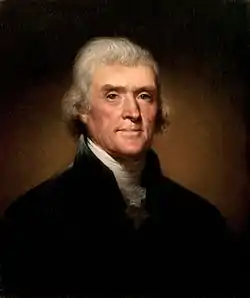
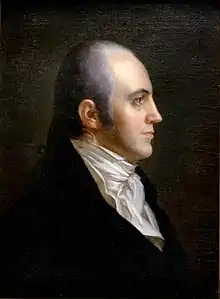
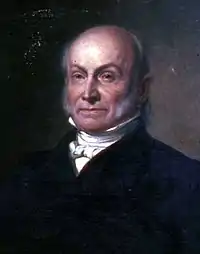
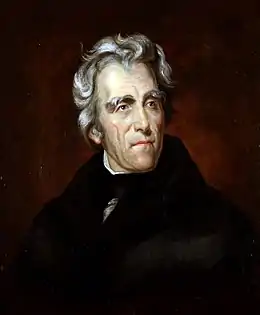
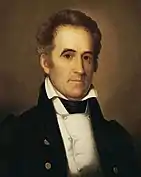
.jpg.webp)